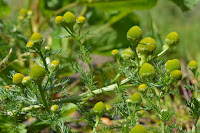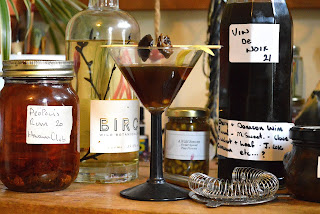I first came across Vin de Noix in the autumn of 2019, courtesy of my good friend and chef, Josh Whitehead. For me, Vin de Noix, is an alchemical stroke of liquid genius! It is wonderfully aromatic, delightfully complex in taste and worthy of all the time, effort and patience required, to create and eventually, crack open, share and sup with friends, loved ones and pop up diners.
Originating from France, Vin de Noix is the cousin of the Italian, Nocino and the Spanish, Ratafia (all are made with, unripe, green walnuts). Prior to being introduced to Vin de Noix, I had only ever made Nocino and really struggled to get my taste buds around it's strong, over-powering, oily and bitter flavour. Since discovering VDN, my preference definitely flows in the direction of the French version. I also envisage more experimentations with Nocino - a palatable version is required! Perhaps VDN is that version...
The three different versions of VdN that I've made, have all been subtly unique. It's generally been the case of me adding or, subtracting different ingredients, commercial or wild, for no other reason than to produce something different, but nothing too outrageous or out-there-experimental: there's a lot of boozy liquid at stake!
Choosing Your WineThose of you familiar with brewing your own wild wines, especially wines with luscious, deep purple, fruity elements, are already half-way to creating your own take on this stunning tipple (I'll detail some recipe guidelines shortly). For those of you unfamiliar with brewing your own wines, half-decent, shop bought reds will suffice - though don't shirk on price too much! In my experience, the ideal wine needs to be of the medium to full bodied variety, not too heavy in tannins, with robust and rounded, full fruitiness - anything listed as having 'blackberry, damson or black cherry' flavour profiles will suffice. With regards to home brew wines, I've had success with my; Elderberry & Blackberry Wine, Black Cherry Wine and, Damson, Elderberry, Black Cherry & Sloe Wine.
Fortifying Vin de Noix
This really is down to your own personal preference. I've had great success adding; Calvados, Gin, Bison Grass Vodka and Elderberry Liqueur (the latter a home creation). Brandy, Armagnac and Cognac would all work very well, being similar to each other in the 'brandy style' and Rum could work.
I have my doubts when it comes to adding whisky (blended or single malts).
Fortifying the wine is essential as wines generally peak at around 14% alcohol volume, unless home brewed (I had an Elderflower wine that once reached a staggering 20% alc vol!) and 14% is not a high enough alcohol limit to deter potential bacterial growth from the wild ingredients or prevent spoilage in a now, opened bottle of wine.
Wild Ingredients
Unripe Green Walnuts are the backbone of this drink, as is the inclusion of very young, walnut leaves. The young walnuts are generally ripe-for-the-picking around the end of June, and depending on location and environmental factors, you can still find walnuts fit for the task, throughout July. Those with experience and familiarity, regarding the making of Pickled Walnuts or, Glyko Karydaki, will be aware of the timely awareness required for harvesting the walnuts, which is prior to the formation of the shell: if the shell is formed or forming, it's better to allow the nuts to fully ripen on the tree. I pick walnuts for both pickling and glyko'ing and when it comes to making vin de noix, I harvest them approximately 2 weeks earlier, when they're slightly smaller.
Meadowsweet is one of the sacred herbs of the Druids and is very common throughout the British Isles. I can't think of any other native herb/flower, that instils so much joy, delight and happiness, when I'm out gathering. To find yourself, on a warm, summer afternoon, beneath, clear, blue skies, surrounded by a sea of Meadowsweet in perfect-pick-phase, complete with 100's of honey bees, buzzing gently about the same flowers, and to then catch scent of those first, early stalked, freshly opened flowers, is nothing short of sublime, as your senses and awareness are whisked off into the ether realms... (nearly lost myself for a minute there!). Meadowsweet will add delectable notes of vanilla, subtle almond & warm fragrant hay to your drink. Fresh or dried flowers can be used (or both at once) and they'll bring subtle differences in their own right. It's worth the while experimenting to gauge your preference.
Pineapple Weed: Anyone reading this, that played out on the streets as a kid, will remember this wonderful, wild herb. As a child, I knew this plant well, it grew out of the cracks in the pavements and kerb stones, in profusion. I steered clear of touching, crushing, sniffing or picking due to being informed by my parents, that it was poisonous, though that was along with every other plant that wasn't intended to be grown in a garden! Pineapple Weed is related to Camomile, that fabulous herb, with a range of sympathetic healing abilities: I love camomile or pineapple weed as ingredients in my sleepy, take-the-edge-off, herbal teas, especially as a night time tipple. Easy to distinguish and identify, with it's multiple, petal-free, yellow flowers which, on being crushed, emit a distinctly, full-on, pineapple-esque fragrance.
Japanese Rose: This is '
the' most delectably fragrant of all rose species, in my opinion. Both the 5 petalled and multi-petalled varieties. When fresh, the petals are a rich magenta colour, fading as they age and the roses have a powerful, heady bouquet akin to Turkish Delight - I kid you not! Essence of Japanese Rose works so well in homemade Turkish Delight (Elderflower & Rose Turkish Delight...). Adding a half handful (or less) of fresh JR petals to your wine will add a lovely and subtle layer of aroma and flavour, definitely worth playing with. With regards to foraging Japanese Rose, fill your boots! It's classed as a 'non-native invasive' and is generally despised by the conservation brigades. That said, many people love the plants presence so, mindful harvesting is wise. Also, bumble and honey bees love them too, so if you leave a good proportion of petals in place, to actively encourage bee foraging, you'll be rewarded later in the year with fat, plump, juicy rosehips that are also edible - win win!
Fig Leaves: Yes, believe it or not, Fig Trees grow in the UK. They can be a bit, hit and miss, when it comes to ripe fruits but, I've foraged and eaten ripe figs in Leeds - I was conducting a wild food event with an arts charity at the time, compromised mostly of international refugees and asylum seekers, the Syrian women in the group were delighted at finding ripe figs and it triggered many a nostalgic memory and tales of home. Young fig leaves, when dehydrated, develop a coconut aroma and flavour, this imparts well into alcohols and other foods and drinks. Take care when handling fig leaves or the fruits when taken directly from the tree as the white sap can cause skin irritations to those who are sensitive.
Sweet Woodruff: This delicate and appealing, aromatic, woodland herb is a great substitute for
vanilla. Sweet Woodruff contains compounds called, coumarins, and when this plant is dried, those coumarins create a fragrance very similar to Vanilla (and Tonka Beans). Though the plants fragrance is more complex than just Vanilla. Sweet Woodruff is fairly easy to identify and is at it's best, fragrance wise, when it just comes into flower. Mindful and respectful gathering is key, as it's not the most common of plants. When harvesting, don't take all the flowering sections as the plant needs to seed to proliferate.
Commercial Herbs & Spices: Those most widely recommended for inclusion in Green Walnut Wine are, Vanilla, Cinnamon, Clove & Allspice. Familiarity regarding the strength and pungency of these herbs is a bonus. A steady hand is required to prevent over powering the final drink. I generally add up to 10 cloves per 2 litres of liquid (red wine and brandy combined), 1 large Cinnamon Stick and 3-5 Star Anise. I've never added Allspice Berries. I also like to add several, thin strips of Orange Zest and Lemon Zest to mine, I find they add lovely flavour and aromatic notes.
Serving Suggestions: Special occasions such as birthdays, the birth of a new child, new year and
Yule are perfect. Given the time of year that you'll be picking the walnuts, new year and Yule really are perfect, as the drink will have received sufficient time to infuse, funk-up and mellow. Depending on how much you make, little bottles make excellent gifts for loved ones and friends. All this said, a tipple can be enjoyed at any time (though 9am in the morning might not be the most suitable time!). I love a little glass to accompany certain desserts, especially Wild Plum and Meadowsweet Frangipane with Vanilla Cream (yum!)..
I served little glasses to diners attending Sapore D'Estate (Taste of Summer), a seasonal collaboration, hosted alongside La Locanda, a great Italian Restaurant, in Gisburn, Lancashire. Each glass was accompanied with some Glyko Karydaki, a traditional Greek sweet treat, also made with unripe, green walnuts (with honey, cinnamon, almonds, cloves & orange zest).
Read more about 'Taste of Summer' here:
Vin de Noix can also be used to create and flavour cocktails, creating a very unique drink.
I'll be hosting Wild Food Identification Courses and a Wild Drinks Course later this year (2023). If you would like to attend, you can register your interest by emailing me at:
edible.leeds@gmail.com










Comments
Post a Comment